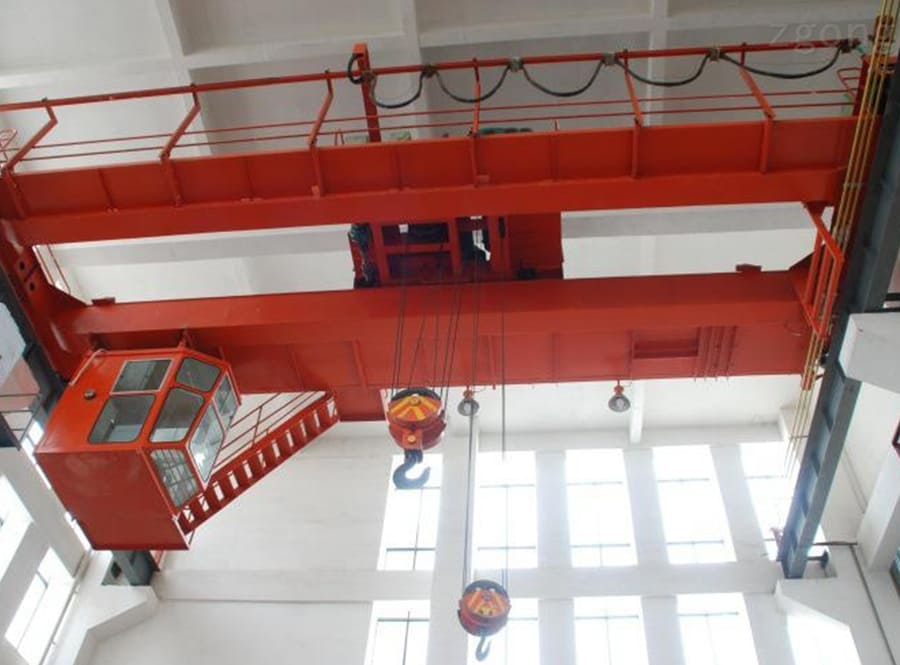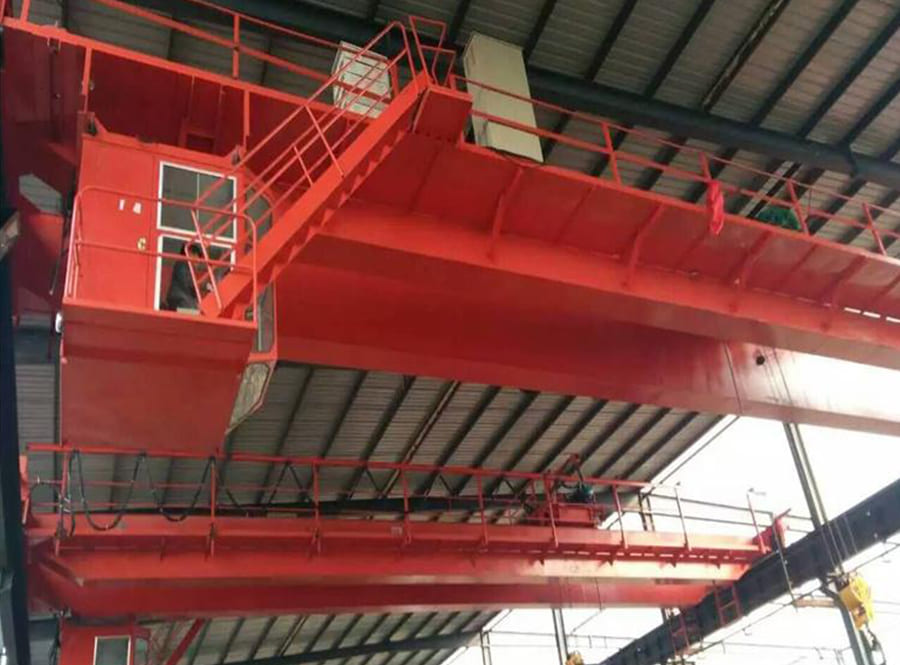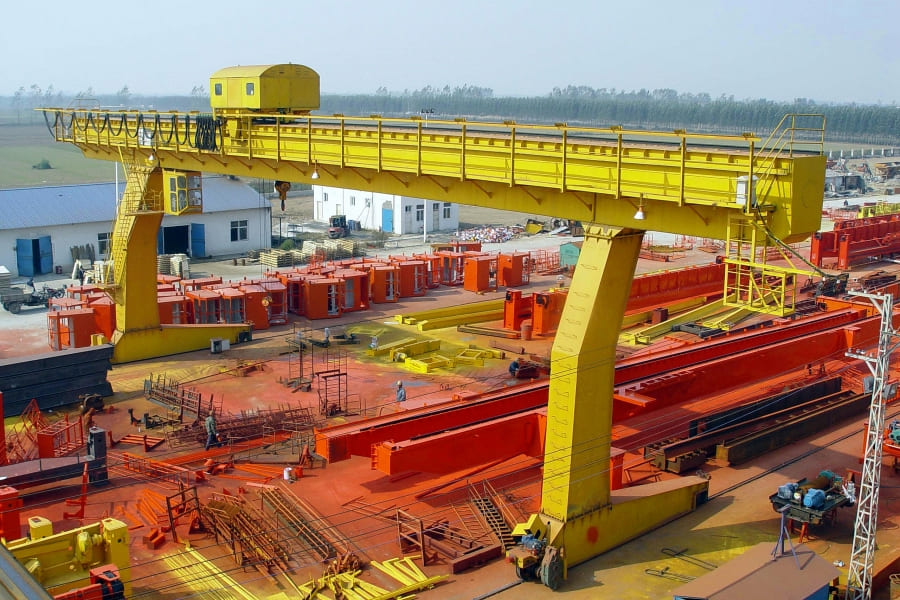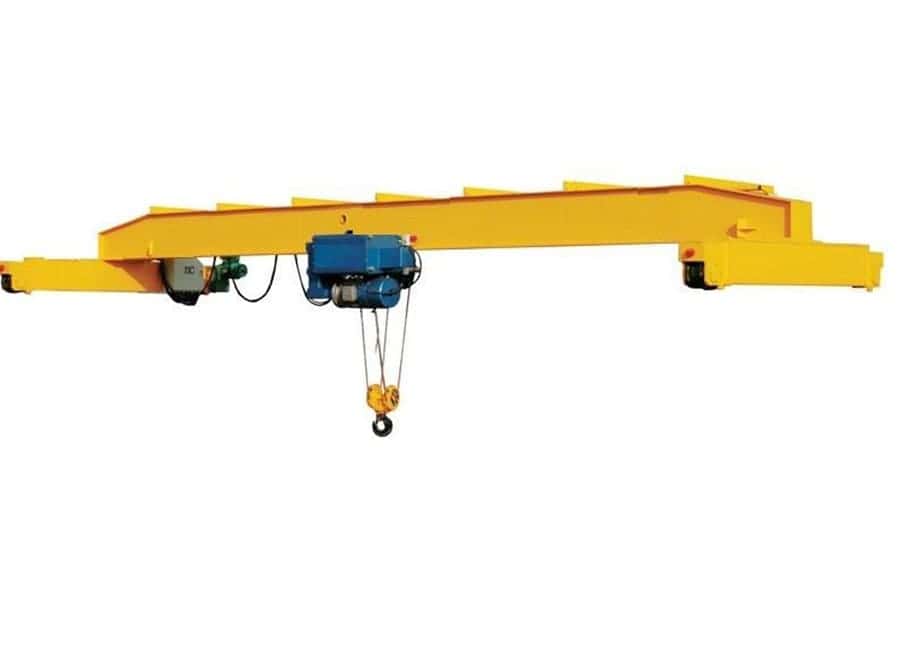Overhead bridge crane for sale is a mechanical equipment that is placed horizontally above workshops, warehouses and open-air storage yards and is used to lift various objects. It is usually called an “overhead crane” or “driving crane”. It is the most widely used lifting machinery in the mechanical industry, metallurgical industry and chemical industry.
As the frequency of use of enterprises becomes higher and higher, during normal use and maintenance, the overhead hoist i beam will often have rail gnawing. Next we will analyze this phenomenon.

Definition of rail chewing
Rail gnawing means that during the operation of the crane trolley or trolley, there should be a certain gap between the wheel rim of the trolley or trolley and the side of the track. However, due to the horizontal lateral thrust generated by the contact between the wheel rim and the side of the track, the wheel rim and the track side are The friction and wear are often called rail gnawing.
Dangers of rail chewing
①. Reduce the service life of wheels
Since the wheels of bridge gantry cranes are generally made of cast steel, they can generally be used for more than 10 years after quenching and other processes. However, due to rail gnawing, the life of the wheels will be greatly reduced, which will seriously affect production safety and production efficiency.
②. Worn track
The occurrence of rail gnawing, due to the rigid contact between the wheels and the track, will aggravate the wear of the track to a certain extent. As the amount of wear increases, the stability of the crane’s large and small trucks decreases, seriously affecting safety.
③.Danger of derailment
When the wheels or rails are severely worn, the wheels may climb to the top of the rails, causing the cart or trolley to derail, causing a safety accident.
④Influence on the structure of the factory building
When used by a crane to gnaw the rails, it will make noise and cause vibrations. Moreover, when the crane is running, it will generate horizontal lateral forces, causing the crane to produce abnormal vibrations. As a result, the factory building structure will vibrate and suffer a certain degree of damage.

Judgment and manifestations of rail chewing
①. On the side of the crane rail, there are obviously friction and shiny flat surfaces, there are very sharp edges on the guide rail, and there are snow-white bright spots on the top surface of the rail.
②. When the bridge crane girder is running, the gap between the wheel rim and the track will obviously become larger or smaller.
③. When the bridge crane is in operation, the body of the bridge crane is skewed and the wheels are deflected.
④. When the cart is running, it will produce a harsh rail gnawing sound. When the rail gnawing is severe, the cart will not only produce a harsh noise, but also cause the cart to beat slightly. This is what we usually call rail climbing.
Analysis of causes of rail chewing
There are many reasons why cranes chew rails, but the main reasons include these two aspects: first, rail deformation; second, defects in crane industrial manufacturing technology and the installer’s insufficient installation ability and technology.
The causes of orbital deformation are as follows:
①. Since the crane’s trolley and trolley often walk back and forth on the track, the pressure on the track is intermittent externally, while the stress inside the track is in the form of alternating stress, which goes back and forth repeatedly. If it acts, the track will be deformed or displaced.
②. Under ideal design, the traveling mechanism of the crane and its large truck travels in a straight line. But in actual work, you have to walk with a load, so this will not have any impact. However, different companies have different management methods and the operating skills of the staff are also different. This will lead to the phenomenon of external pulling and diagonal lifting. This phenomenon It will definitely chew the rails.
③.The track foundation changes. Such as geological subsidence. Whether the crane can move normally mainly depends on the condition of the track. The most commonly used method at present is to constantly adjust the track.
The installation quality of the wheels and the quality of the wheels themselves are also important causes of rail chewing:
①. The long-term overload operation of the underhung bridge crane, or the residual stress of the crane’s main beam, etc. cause the crane’s main beam, end beam, and frame to deform, causing the wheels to skew and causing rail gnawing.
②.The diameters of the treads of the two driving wheels are not equal. When the crane is running, because the wheel diameters are different, the wheels on both sides must run at different speeds when the motor speed is the same, which will cause the “circling” phenomenon, causing the wheel rim to be in rigid contact with both sides of the track, causing rail gnawing. .
③. The driver host is not synchronized. The two motors running on the driven cart have different speeds or one side of the motor is damaged, resulting in different linear speeds of the wheels, causing the overall car body to deviate and causing rail chewing; the transmission gap difference between the couplings at both ends is too large, causing The wheels cannot be started at the same time, which will also cause rail chewing.
④.The wheels and tracks do not match. If the wheels don’t match the track. If the gap is too small, the wheel rim will come into contact with the side of the track, causing rail chewing; if the gap is too large, the same situation will occur. The four wheels are not on the same level, causing one of the driving wheels to hang or slip, causing the car body to run skewed; at the same time, debris on the top of the track causes the wheels to run at inconsistent speeds. These are all causes of rail chewing.
Rail chewing solutions
Correction track
After the new track is installed, it must be strictly adjusted before it can be put into use. Corresponding tools should be prepared before adjustment, such as steel tape measure, level, tensioner and thin steel wire. Use a steel tape measure to measure the gauge between the two rails, and use a spirit level to measure whether the level of the two rails is consistent. Use tensioners and thin steel wires to adjust track level and straightness. When installing the wheel, the horizontal deviation should be controlled at △≤L/1000 (L is the length of the measured diameter of the wheel on the parallel reference line), and the vertical deviation should be controlled at △≤H/1000 (H is the measured height of the wheel in the vertical direction) length).
The methods and requirements for adjusting the old track are roughly the same as adjusting the new track, except that before adjusting the old track, it should be inspected in detail. The inspection contents include:
① Check whether there are cracks or breaks in the track.
② Check whether all bolts and nuts are loose or damaged.
③ Check whether the pressure plates and gaskets of all tracks are damaged.
④ When calibrating the entire track, use appropriate tools and accurate methods to measure the track gauge, levelness and horizontal straightness errors of the two rails, and record them.
Solve rail chewing by adjusting wheels
By replacing worn wheels in pairs, the impact of wheel diameter differences on operation can be eliminated, and the installation accuracy of the wheel set can be adjusted. Reduce manufacturing errors in the wheel set itself.
Check and calibrate transmission mechanism
① Through careful inspection of the transmission mechanism, if it is found that the gap in the transmission mechanism is large, the coupling and gearbox must be inspected or replaced.
② First adjust and install the driving wheel of the cart, and then use this as a basis to level the horizontal axis between the integral coupling, reducer and traveling motor of the cart. To avoid shifting, use Weld the reducer firmly with the positioning block.
③ Check and adjust the motor speed on the transmission mechanism. If the motor speeds on both sides are still inconsistent, it is recommended to replace them with motors of the same manufacturer and model.
④ Adjust the brakes at both ends in a consistent manner, that is, the brakes at both ends are fully opened without additional frictional resistance during operation. This can prevent unequal braking torques and rail-gnawing by the crane during braking.





















